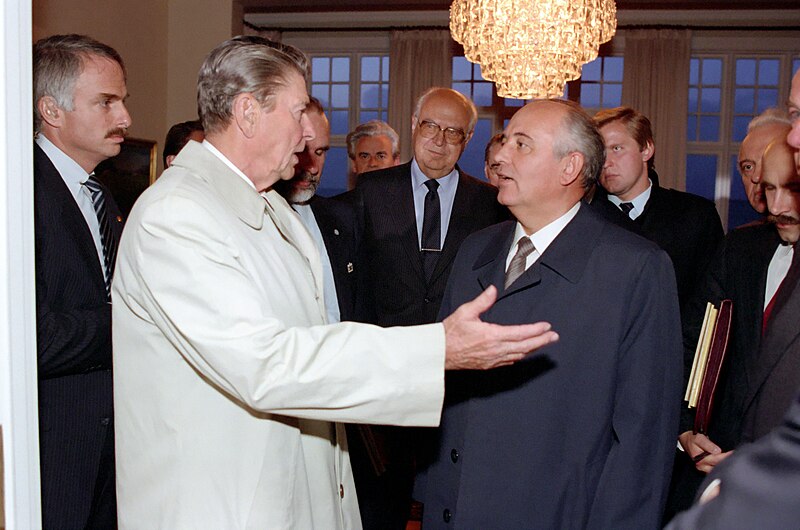 U.S. President Ronald Reagan and Soviet General Secretary Mikhail Gorbachev at Hofdi House in Reykjavik Iceland, 10/12/1986.
U.S. President Ronald Reagan and Soviet General Secretary Mikhail Gorbachev at Hofdi House in Reykjavik Iceland, 10/12/1986.
The Importance and Future of U.S.-Russia Cooperation
In November of 1983, the American military exercise Able Archer 83 almost commenced a nuclear apocalypse. Unbeknownst to the Americans, Soviet intelligence and leadership believed the exercises were a cover for a first strike and prepared their nuclear forces. If further miscommunication occurred, nuclear war would have been likely. 40 years since the world was on the precipice of annihilation, Russian-American relations are nearing Cold War lows, and Russia’s decision to withdraw from the Comprehensive Nuclear Test Ban Treaty last month could send the world back to an era of duck and cover.
The perennial question of Russian-American relations is how to coexist despite differing geopolitical ambitions—all under the threat of nuclear annihilation. Rapprochement (a re-establishment of cordial or harmonious relations) between the U.S. and Moscow has happened before and will need to happen again. American policymakers should begin to envision under what circumstances rapprochement can occur, what it will look like, and how rapprochement can further both countries’ interests.
Since 1945, there have been two significant rapprochements with Moscow—with varying degrees of success. The first rapprochement, called détente, lasted from the Cuban Missile Crisis until the Soviet invasion of Afghanistan. During this period, the Soviet Union and the U.S. signed treaties such as the Nuclear Non-Proliferation Treaty, Strategic Arms Reduction Treaty (SALT), and the Anti-Ballistic Missile Treaty. They also signed the Helsinki Final Act, which some scholars argue helped lead to the end of authoritarian communist regimes in Eastern Europe. The second period of rapprochement was from the mid-1980s until the collapse of the Soviet Union in 1991. A personal relationship between U.S. President Ronald Reagan and Soviet General Secretary Mikhail Gorbachev highlighted this period. New bilateral treaties were signed such as the Intermediate-Range Nuclear Forces Treaty and SALT II.
While there were still tensions during both periods—both countries fought proxy wars against each other— there was finally movement away from the threat of annihilation. But the clouds of malaise and brinksmanship have reappeared. Russia blames the U.S. for beginning this downward style through NATO’s expansion into Eastern Europe, America’s pull out of the Anti-Ballistic Missile Treaty in 2001, and its invasion of Iraq in 2003. The U.S. would counter, arguing that Russia’s invasions of Georgia in 2008, Crimea in 2014, and again Ukraine in 2022 have caused significantly more damage to the U.S.-Russia relationship. Regardless, both countries need to find a way to live with the other.
The U.S. needs to consider under what conditions rapprochement with Russia would be appropriate. If Russia’s invasion of Ukraine continues in its current form, rapprochement will be politically infeasible. But the path the conflict will take is uncertain. Rapprochement will, in many ways, depend on how the conflict concludes. An outright Ukrainian or Russian victory, frozen conflict, or settlement will lead to different outcomes. Who leads Russia will matter too. Could American leaders ever cooperate with Russia if Vladimir Putin is in power? If Putin is not in power, is it someone more reactionary or more moderate? These questions will matter if Russian and American leaders wish to form a rapport like Reagan and Gorbachev, or Clinton and Yeltsin.
There are areas where cooperation is necessary. The most obvious is the revival and strengthening of nuclear missile treaties. The U.S. and Russia still hold the most nuclear weapons in the world, and working to reduce the amount and ways they are deployed would help temper fears of mutually assured destruction and set a positive precedent for other agreements with nuclear-armed countries such as China. Other issues, such as the Arctic and cyber security, in which both the U.S. and Russia are decisive players, could be future issues both countries bilaterally resolve.
Rapprochement is in the long-term interests of both countries. For Russia, its demographic crisis will be exacerbated by the war as more of its young men come home in coffins. With fewer young men comes fewer workers, leading to economic stagnation and recession, worsened by global sanctions. Rapprochement could mean the difference between further stagnation and sustainable demographic and economic growth. For the U.S., rapprochement with Russia can help ease demand on a country with limited military and diplomatic resources. It can allow the U.S. to finally accomplish its pivot towards Asia, a wishful goal since the early 2010s. And rapprochement may prevent a formal Sino-Russian alliance, which would both be a geopolitical disaster for the U.S. and push the world towards a third global catastrophe.
If U.S.-Russian relations continue to deteriorate, the risk of nuclear war will increase. While rapprochement will not happen until the war in Ukraine concludes, it is both countries’ moral duty to get there eventually. Both sides can choose not to be enemies. They can cooperate when their interests are aligned and effectively communicate when opposed. But until that happens, midnight inches ever closer.





